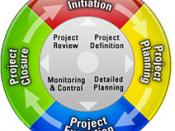Quality ManagementNow that our project is complete, it is time to explore the aspects of quality and how it is involved in our project. Every project needs a quality plan, no matter how difficult it may seem to develop one. There are certain standards that need to be upheld throughout any project in order to ensure the final project is usable. Mature organizations easily admit they cannot completely define quality. The customer defines quality (Kerzner, 2007). According to Howard and Shelley Gitlow, "Quality should be defined as surpassing customer needs and expectations throughout the life of the product." Terms such as fitness for use, customer satisfaction, and zero defects are project goals rather than definitions (Kerzner, 2006).
Key ConceptsThere are six quality management concepts that should support every project. These concepts are:ÃÂQuality policyÃÂQuality objectivesÃÂQuality assuranceÃÂQuality controlÃÂQuality auditÃÂQuality program plan (Kerzner, 2006)Our quality policy states the level of quality we expected for this project.
We developed an upgrade for our email system. It required new protocols, and integrating our five email systems into one finished product. All PCÃÂs had to be upgraded in order to be compatible. As the project manager I developed a quality program plan with my team members. The quality program plan broke down the project activities into a work breakdown structure. Then it was further broken down into lower-level tasks until specific quality actions could be identified. The quality objective was to complete this project in a timely manner. These were goals we set during the planning phase of our project. It included project implementation to training of employees on the new system. Quality assurance includes all formal activities and managerial processes that ensure that products and services meet the required quality level (Kerzner, 2006). Quality control includes continually monitoring processes, identifying and...


